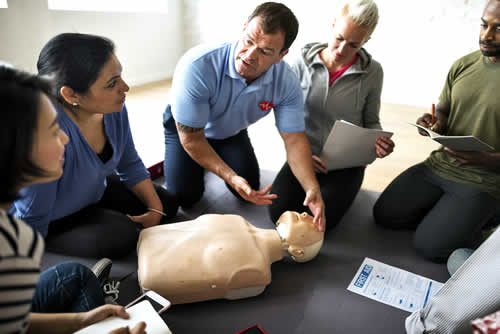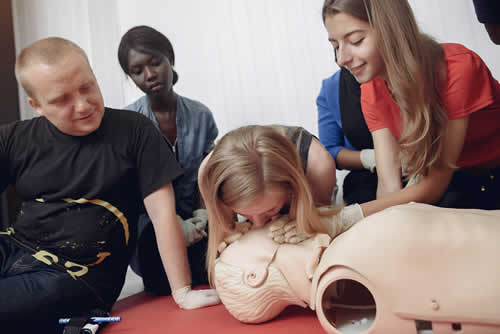You’re at dinner when someone at the next table starts choking. You freeze for half a second, but then it kicks in—you remember your CPR training. You step in, act fast, and save a life.
Now imagine that same moment... but your training’s expired. You hesitate, unsure, and those few seconds change everything.
That’s why renewing your CPR certification isn’t just a checkbox exercise - it’s a way to keep your confidence alive and your skills fresh. For instance, according to the Sudden Cardiac Arrest Foundation, the survival rate to hospital discharge after EMS-treated out-of-hospital cardiac arrest (OHCA) is only 9%, and just 7% survive with good functional status.

In this guide, we’ll walk you through exactly when to start your renewal so you’re never caught off guard when someone truly needs your help.
Why CPR Training Matters for Volunteers
Volunteer organizations are often the first line of support during emergencies, community events, and disaster relief efforts. This is where CPR training becomes indispensable for volunteers during unprecedented emergencies. Here’s how it benefits the volunteers.
Immediate Life-Saving Action
CPR enables you to give immediate care during a cardiac arrest. When you’re trained, you can act quickly and effectively rather than feeling helpless while waiting for emergency responders to arrive.
Empowering You to Respond with Confidence
The training prepares you mentally and emotionally to stay calm and composed in high-pressure situations. This confidence allows you to take charge and inspire confidence during emergencies.

First Responder Advantage
In many volunteer roles, especially at public events or in disaster zones, you may be the first on the scene. Your certification ensures you are an active first responder who can provide critical care until professionals arrive.
Protecting Vulnerable Populations
Volunteer organizations often serve children, the elderly, or individuals with disabilities, groups at higher risk for medical emergencies. Your training equips you to protect these vulnerable populations, making your organization safer and more inclusive.
Understanding Course Pricing
The economics of delivery involve instructor fees, certification expenses, materials, and sometimes venue costs, all of which can add up quickly for organizations operating on tight budgets. For many nonprofits and community groups, these expenses can be the deciding factor in whether they can offer it to their volunteers at all. Funding
has been repeatedly cited as one of the biggest barriers to implementing CPR programs, even in schools where training is mandated by law.
When you start planning certification for your volunteers, you will quickly discover a wide spectrum of pricing. This variability reflects differences in course content, delivery format, provider reputation, and included materials. Let’s break down the landscape so you can make informed decisions for your organization.
- Basic CPR or CPR/AED Course ($20–$60): Covers essential skills for adults, children, and infants, including AED use. Ideal for most volunteers and workplace requirements.
- CPR with First Aid ($50–$140): Adds training on handling burns, wounds, choking, and other emergencies. Commonly required for childcare providers and teachers.
- BLS (Basic Life Support) for Healthcare Providers ($60–$300): Designed for medical professionals, covering advanced CPR, bag-mask technique, and team dynamics.
- ACLS (Advanced Cardiovascular Life Support) ($100–$300): For advanced healthcare roles, including ECG interpretation and medication protocols.
- Pediatric CPR ($25–$50): Focuses on infant and child emergencies for daycare staff, parents, and pediatric nurses.
- Online CPR Certification ($14–$70): Convenient, self-paced, and budget-friendly, but may not meet all employer or regulatory requirements.
- In-Person CPR Class ($40–$300): Provides hands-on practice and immediate feedback, often required for healthcare and education jobs.
- Blended Learning ($75–$125): Combines online theory with in-person skills checks, balancing convenience and practical experience.

What are the factors influencing CPR course pricing?
As you compare options, you should understand what drives the CPR course pricing tag. Several interrelated factors contribute to the final cost per participant. It includes,
- Course Type and Content — The depth and breadth of the course directly affect pricing. Basic CPR is more affordable, while courses that include first aid, BLS, ACLS, or pediatric components command higher fees.
- Format — In-person classes are more expensive, while online courses are budget-friendly, eliminating overhead costs and offering flexibility.
- Provider Reputation and Accreditation — Certifications from established organizations often come at a premium, while local providers may offer lower prices.
- Group Size and Customization — Training providers often offer group discounts for larger enrollments. In contrast, customiziation to your needs is likely to increase the price.
- Materials and Add-Ons — Some courses include printed manuals, pocket masks, and practice dummies in the base price, while others may charge extra for this material, adding to the total cost.
Cost-Saving Strategies for Volunteer Organizations
Every dollar matters for volunteer organizations. Fortunately, there are several proven strategies to stretch your budget without sacrificing quality or compliance. Some of them are,
Leverage Online and Blended Learning
Online CPR and first aid courses are more affordable and also highly accessible. Your volunteers can complete their courses at their own pace, from anywhere, eliminating travel and venue costs. In fact, online learners perform as well as those in traditional classrooms, with similar skills acquisition and retention. For renewals or basic certifications, online options are especially cost-effective.
Organize Group Bookings for Discounts
Many providers offer big discounts for group enrollments. By training your volunteers as a cohort, you can negotiate lower per-person rates. In a similarl way, scheduling group renewals at regular intervals can help you secure lower rates and ensure your team’s skills remain current, reducing last-minute expenses and administrative headaches.
Choose the Right Course Level for Your Needs
Not every volunteer needs advanced certification. Assess your organization’s requirements and select the most appropriate course type. For most community roles, basic CPR/AED or CPR with first aid is sufficient, preventing wasting money on courses that aren’t needed.

Partner with Local Agencies and Seek Grants
Look at possible partnerships with local health departments, hospitals, or emergency services. These organizations sometimes offer free or subsidized prices for community groups. Additionally, seek out grants or funding opportunities dedicated to public health and safety initiatives—many government and private foundations support CPR training for nonprofits and volunteer organizations.
Check for Employer or Community Reimbursement
Some employers, schools, or community organizations offer reimbursement or direct payment for training, especially if it’s a job requirement. Before enrolling, ask your HR department or local partners if they have preferred provider arrangements or funding support.
Stay Informed and Apply Early
Grant CPR training programs often have strict deadlines and limited funds. Subscribe to newsletters from grant portals, government websites, and relevant organizations to receive timely updates. Early application submission allows you to pay a discount to enrol.
Evaluating Online vs. In-Person Training
Selecting the right format significantly impacts your learning effectiveness and emergency preparedness. Learning the differences between online and in-person training helps you make an informed decision that aligns with your learning style, budget, and schedule. Here’s a brief differentiation between online vs. in-person options.
Aspect |
Online |
In-Person |
Cost |
More affordable |
Higher costs for materials and instruction |
Flexibility |
Learn at your own pace, anywhere with internet |
A fixed schedule may conflict with availability |
Hands-on Practice |
Limited practical experience |
Direct practice with equipment and mannequins |
Instructor Feedback |
No immediate feedback |
Real-time feedback and correction |
Accessibility |
Available 24/7, no travel required |
Requires travel to the location |
Learning Environment |
Self-directed, requires discipline |
Interactive group setting |
Material Review |
Can review content multiple times |
Limited opportunities to repeat sessions |
Skill Assessment |
May struggle with practical evaluation |
Better hands-on skill assessment |
Technical Issues |
Potential disruption from tech problems |
No technical dependencies |
Social Interaction |
Minimal peer contact |
Collaborative learning with others |
Empower Your Volunteers, Enrich Your Community
The global CPR training market, as reported by Data Insights, is projected to grow from $250 million in 2025 to $420 million by 2033, driven by increased awareness and government initiatives. Despite its significance, awareness and training gaps remain visible. Don’t let budget constraints stand in the way of preparedness. Explore the
CPR course pricing, weigh your options, and apply smart cost-saving strategies to equip your team with the skills and confidence they need without straining your budget.
Ready to take the next step? Well, we hope you’ll now consider it a wise move to enrol your team in an online CPR course. It will offer flexibility, affordability, and up-to-date content, making it an ideal choice for cost-effective upgrades to what often turn out to be life-saving skills.




























